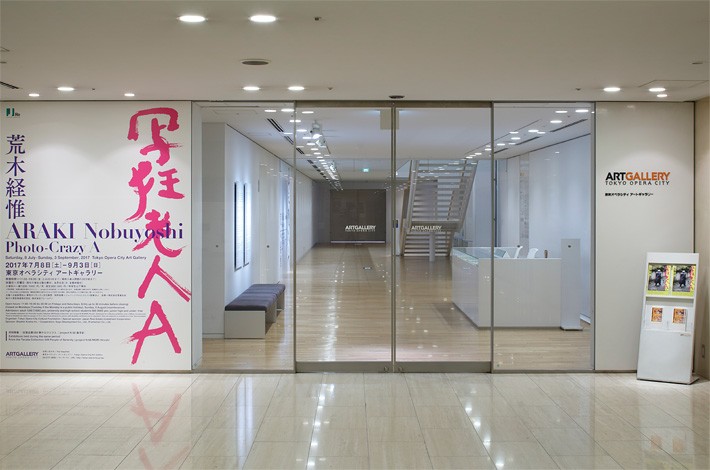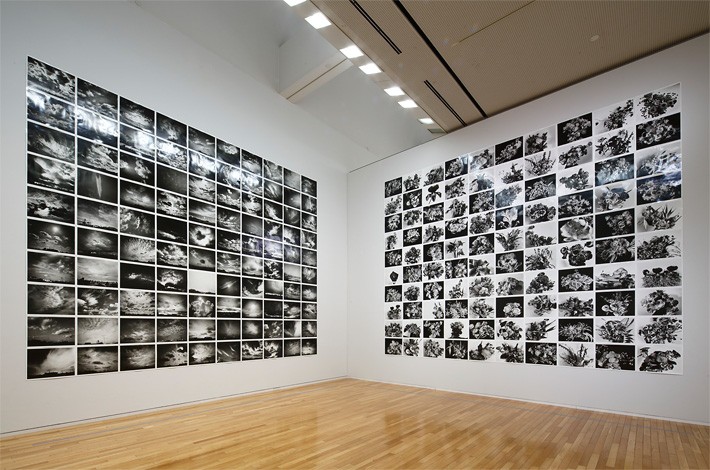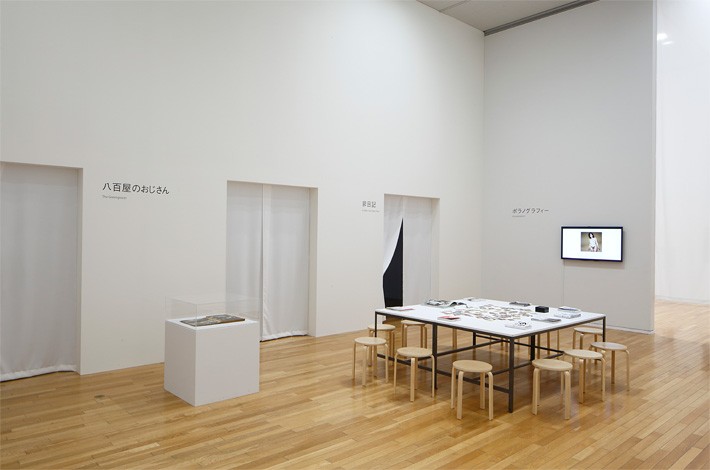Araki Nobuyoshi
08 Jul - 03 Sep 2017
ARAKI NOBUYOSHI
Photo-Crazy A
8 July –3 September 2017
Curation : Hiromi Kitazawa (Guest Curator)
As well as the new works that form its core, the exhibition also includes some early photographs and ongoing projects. It is divided into nine sections: Dai Koga (Grand Light Picture Scroll); One Hundred Views of the Sky; One Hundred Views of Flowers; Shakyo Rojin A Nikki 2017.7.7 (A Diary 2017.7.7); The Greengrocer; POLANOGRAPHY; Hi-Nikki (Non-Diary Diary); Yuen no Onna (Captive Women in a Pleasure Garden); and Setsujitsu (Ripping The Truth).
1. Dai Koga (Grand Light Picture Scroll) (New work)
This is one of Araki’s latest series, depicting married women of varied ages. The women’s evident trust of their photographer allows them to transcend a form of self-presentation that is merely sexual to celebrate with their beings the joys of living, and Araki’s camera responds to this transformation with unconstrained encouragement. The presentation of these photographs in the manner of giant scroll-paintings from Japanese history serves to enhance the powerful life force inherent in the pictures. Araki himself has deemed this series “the closest thing to photography as I conceive of it now.” The series also provides an antithesis to homogenous standards of beauty and to the pin-up.
2. One Hundred Views of the Sky (New work)
As its title suggests, this series comprises 100 monochrome prints of the sky, as seen from Araki’s balcony. The concept is a reference to Katsushika Hokusai’s woodblock print series, One Hundred Views of Mount Fuji. For Araki, the sky is the “most formidable” of photographic subjects, and in these works, which seem to construe the passing clouds, the weather conditions, and the light and shadows all as sheer “objects,” we sense Araki’s thoughts reaching toward the matter of this world and the other.
3. One Hundred Views of Flowers (New work)
Inspired by the Hundred Flowers produced by the Edo-period painter Ito Jakuchu, this series is composed of 100 monochrome prints of flowers in various states, blooming exquisitely or wilting away. The multilayered and delicate gradation visible here speaks to the way in which Araki makes the most of the rich expressive potentiality of monochrome photography. Doing away here with the dolls and similar props that often appeared in his photographs up until now, these works represent a purer form of photographic sensibility.
4. Shakyo Rojin A Nikki 2017.7.7 (A Diary 2017.7.7) (New work)
These are the latest additions to Araki’s Nikki (Diary) series he has worked on throughout his career. All the photographs on display, which number nearly 700, are marked with the date July 7, 2017—the anniversary of Araki’s wedding to his now-deceased wife Yoko. The photos document everyday scenes, without arbitrary elements, and are displayed in the order in which they were taken. They bring to mind vividly the themes of the flow of time that lends colour to our lives, and the glimpses of life and death found within our daily existence.
5. The Greengrocer (Early work; shown for the first time 50 years after its creation)
The Greengrocer is the first volume of one of Araki’s early scrapbooks. To this day, Araki continues to value scrapbooks as important starting point for his work. The scrapbook presents pictures of the Ginza greengrocer who Araki often passed during the time when he was working for Dentsu (1963-72). Resonant with human feeling, the photos bring to mind the techniques for capturing people’s lives often used in movies. The display includes a projected slideshow of all the pages of the scrapbook, showing their charm to full effect.
6. Polanography (From an ongoing project)
In this section, we present archive footage of Araki’s exhibitions of polaroids and of the polaroids themselves. He has been holding these exhibitions since 2002. In the polaroids, Araki puts the medium to masterful effect in capturing daily events and the flow of time. The playful title was devised by Araki himself, and is typical of his talent for experimenting with language.
7. Hi-Nikki (Non-Diary Diary) (From an ongoing project)
The digital camera works presented as a slideshow in this section are extracted from a series that was featured in a project for Fondation Cartier in Paris in 2014, and still continues on a subscription website. The title of the series, referring to how the photos are “less a diary, more a transcript of time,” also relates to the way that digital photography is “non-photography photography,” thereby encapsulating Araki’s paradoxical and rather detached approach to the digital medium.
8. Yuen no Onna (Captive Women in a Pleasure Garden) (New work)
Women in kimonos, who look as though they’ve been transported straight from an ukiyo-e picture, are often seen as Araki’s trademark. This is especially the case overseas, where this imagery represents something exotic and quintessentially Japanese. These latest works by Araki use not professional models, but rather amateur married women as their subjects. Here Araki tends to serve as a zegen figure, a man who captures women seeking to flee the pleasure quarters and sells them back, but looking at these images, we have to ask who the true captive in this situation is...
9. Setsujitsu (Ripping the Truth) (New work)
From very early on in his career, Araki experimented with snipping and cutting his work and creating collages with it. The Setsujitsu works, in which the artist has cut up countless prints of his and rearranged them into collages, are his latest in this experimental vein. Araki speaks of cutting up and creating collages as generating the same sensation as pushing the shutter of the camera. The title Araki has chosen here is a complex cluster of allusions, which suggests an opposition to the idea of photographs as capturing the truth (shinjitsu), instead cutting or ripping the truth to become setsujitsu (compelling). The word also echoes the word “setsunai,” meaning sad or melancholic.
Photo-Crazy A
8 July –3 September 2017
Curation : Hiromi Kitazawa (Guest Curator)
As well as the new works that form its core, the exhibition also includes some early photographs and ongoing projects. It is divided into nine sections: Dai Koga (Grand Light Picture Scroll); One Hundred Views of the Sky; One Hundred Views of Flowers; Shakyo Rojin A Nikki 2017.7.7 (A Diary 2017.7.7); The Greengrocer; POLANOGRAPHY; Hi-Nikki (Non-Diary Diary); Yuen no Onna (Captive Women in a Pleasure Garden); and Setsujitsu (Ripping The Truth).
1. Dai Koga (Grand Light Picture Scroll) (New work)
This is one of Araki’s latest series, depicting married women of varied ages. The women’s evident trust of their photographer allows them to transcend a form of self-presentation that is merely sexual to celebrate with their beings the joys of living, and Araki’s camera responds to this transformation with unconstrained encouragement. The presentation of these photographs in the manner of giant scroll-paintings from Japanese history serves to enhance the powerful life force inherent in the pictures. Araki himself has deemed this series “the closest thing to photography as I conceive of it now.” The series also provides an antithesis to homogenous standards of beauty and to the pin-up.
2. One Hundred Views of the Sky (New work)
As its title suggests, this series comprises 100 monochrome prints of the sky, as seen from Araki’s balcony. The concept is a reference to Katsushika Hokusai’s woodblock print series, One Hundred Views of Mount Fuji. For Araki, the sky is the “most formidable” of photographic subjects, and in these works, which seem to construe the passing clouds, the weather conditions, and the light and shadows all as sheer “objects,” we sense Araki’s thoughts reaching toward the matter of this world and the other.
3. One Hundred Views of Flowers (New work)
Inspired by the Hundred Flowers produced by the Edo-period painter Ito Jakuchu, this series is composed of 100 monochrome prints of flowers in various states, blooming exquisitely or wilting away. The multilayered and delicate gradation visible here speaks to the way in which Araki makes the most of the rich expressive potentiality of monochrome photography. Doing away here with the dolls and similar props that often appeared in his photographs up until now, these works represent a purer form of photographic sensibility.
4. Shakyo Rojin A Nikki 2017.7.7 (A Diary 2017.7.7) (New work)
These are the latest additions to Araki’s Nikki (Diary) series he has worked on throughout his career. All the photographs on display, which number nearly 700, are marked with the date July 7, 2017—the anniversary of Araki’s wedding to his now-deceased wife Yoko. The photos document everyday scenes, without arbitrary elements, and are displayed in the order in which they were taken. They bring to mind vividly the themes of the flow of time that lends colour to our lives, and the glimpses of life and death found within our daily existence.
5. The Greengrocer (Early work; shown for the first time 50 years after its creation)
The Greengrocer is the first volume of one of Araki’s early scrapbooks. To this day, Araki continues to value scrapbooks as important starting point for his work. The scrapbook presents pictures of the Ginza greengrocer who Araki often passed during the time when he was working for Dentsu (1963-72). Resonant with human feeling, the photos bring to mind the techniques for capturing people’s lives often used in movies. The display includes a projected slideshow of all the pages of the scrapbook, showing their charm to full effect.
6. Polanography (From an ongoing project)
In this section, we present archive footage of Araki’s exhibitions of polaroids and of the polaroids themselves. He has been holding these exhibitions since 2002. In the polaroids, Araki puts the medium to masterful effect in capturing daily events and the flow of time. The playful title was devised by Araki himself, and is typical of his talent for experimenting with language.
7. Hi-Nikki (Non-Diary Diary) (From an ongoing project)
The digital camera works presented as a slideshow in this section are extracted from a series that was featured in a project for Fondation Cartier in Paris in 2014, and still continues on a subscription website. The title of the series, referring to how the photos are “less a diary, more a transcript of time,” also relates to the way that digital photography is “non-photography photography,” thereby encapsulating Araki’s paradoxical and rather detached approach to the digital medium.
8. Yuen no Onna (Captive Women in a Pleasure Garden) (New work)
Women in kimonos, who look as though they’ve been transported straight from an ukiyo-e picture, are often seen as Araki’s trademark. This is especially the case overseas, where this imagery represents something exotic and quintessentially Japanese. These latest works by Araki use not professional models, but rather amateur married women as their subjects. Here Araki tends to serve as a zegen figure, a man who captures women seeking to flee the pleasure quarters and sells them back, but looking at these images, we have to ask who the true captive in this situation is...
9. Setsujitsu (Ripping the Truth) (New work)
From very early on in his career, Araki experimented with snipping and cutting his work and creating collages with it. The Setsujitsu works, in which the artist has cut up countless prints of his and rearranged them into collages, are his latest in this experimental vein. Araki speaks of cutting up and creating collages as generating the same sensation as pushing the shutter of the camera. The title Araki has chosen here is a complex cluster of allusions, which suggests an opposition to the idea of photographs as capturing the truth (shinjitsu), instead cutting or ripping the truth to become setsujitsu (compelling). The word also echoes the word “setsunai,” meaning sad or melancholic.





